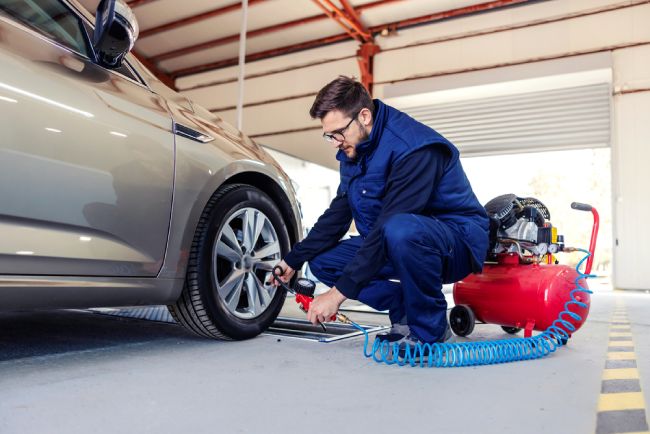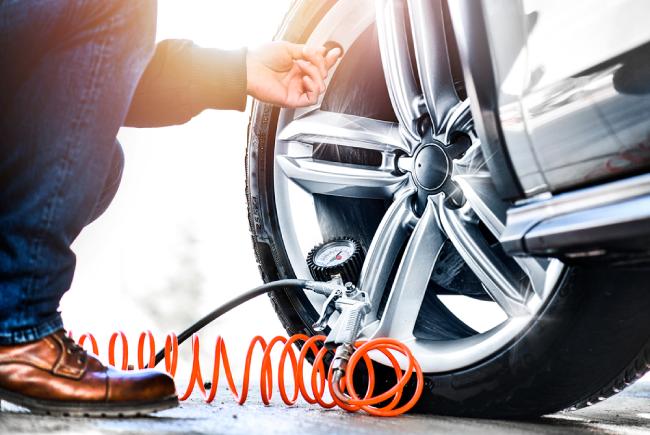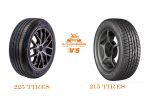Maintaining the proper tire pressure helps increase the life of your tires and save on fuel consumption which saves you money. Regularly checking your tire pressure also helps ensure the tires are correctly inflated and alert you to a slow leak, possibly preventing a flat.
Here you’ll learn how to use a tire gauge and how to use an air compressor safely to inflate tires.
Check these before using the air compressor to inflate tires
-
Protect your hands with gloves
The tires and wheels are grimy. To keep your hands from getting grimy, wear a pair of latex or canvas work gloves while checking the tire pressure and inflating tires.
-
Charge FIRST, then turn on the air compressor
Make sure your air compressor has a full charge before using it. Also, always check the manufacturer’s recommendations before using. Finally, never use the compressor while charging, this will avoid damaging the air compressor.
How to Use an Air Compressor to Inflate Tires?

Tools
- Gloves
- Air compressor
- Tire gauge
Step 1: Check tire pressure specs
Check the driver’s side door for your vehicle’s tire pressure recommendations. If you can’t read the info on the door, look it up in the owner’s manual. You will use the cold start psi measurement.
Step 2: Check the pressure in the tire
Remove the valve cap and check the tire pressure. To check the pressure, place the tire gauge on the valve stem (after removing the cap) and press down on the gauge for a few seconds while the gauge’s PSI (pounds of force per square inch) registers.
Only inflate a tire if the pressure is low than recommended.
Step 3: Inflating the tire using the air compressor
Place the air compressor hose adapter on the valve stem and press the locking lever. Locking it in place holds it securely while the compressor is on and frees your hands. Next, press the compressor switch on and then press the compressor switch to on.
Watch the dial on the compressor and switch it off as soon as the pressure reaches the level you need. For example, if you need a psi of 45 in your tire when it reaches 45 psi, turn the machine off.
Warning: Do not overinflate the tire
Step 4: Remove the air compressor
Once you reach the psi recommended, turn off the compressor and remove the hose from the valve stem. Recheck the pressure using the tire gauge.
If you are under pressure, repeat step #3 until the pressure is at the recommended psi. If you are above the recommended pressure, use the tire gauge to let out some air until you reach the optimum tire pressure.
Now replace the valve stem cap.
The info you need to use an air compressor to inflate tires
-
The 4 PSI rule
This rule of thumb uses 4 psi to ensure your tire pressure is spot on. It works in any condition, on all terrains. After filling your tire to the recommended psi, take the car for a ride.
You need to drive at least an hour to get the tires warm enough to retest the psi. Once you have returned from the drive, recheck the tire’s pressure using the tire gauge.
Don’t get discouraged if it is not spot on after the first drive. Practice makes perfect, especially when filling tires. If your post-ride pressure is 42, you are golden. You can put away your equipment. If the tire pressure is 4 psi lower than before the drive, your pre-drive pressure is too high.
Your starting pressure was too low if the pressure was 4 psi above the recommended psi. Now you can adjust the pressure 2 psi in either direction and use this as the new cold start pressure.
This example may clarify this – your cold start pressure is 40 psi but post-ride, the psi is 46, higher than you want. So, you want to increase the cold start pressure to 42 psi. Then, take another ride and recheck the post-ride psi.
If the post-ride pressure is 42, you are short the 4 psi. So 38 will be the cold start pressure. Now drive around again and recheck your tire pressure. As I said earlier, it takes practice to get this right the first time.
Quick tip: Make sure you decrease your speed to match the decrease in the tire pressure.
-
Adaptor
The adaptor may need to be changed if you fill a smaller tire, such as a bike or trailer tire.
Quick tip: Inflate smaller tires slowly so they don’t explode!
Avoiding common mistakes
- Try using a pressure regulator if you aren’t sure you can turn off the compressor at the correct psi
- For the best tire performance, do not overinflate or underinflate your tires
- If you are not sure you know what you are doing, call a professional
- Make sure your tires, power source, valve, air compressor, and all needed components are compatible before starting
- Only use the owner’s manual recommended settings
- Avoid driving on a low-pressure tire; it is dangerous
- Never walk away from a running air compressor
Air compressor maintenance tips
- When not in use, store your compressor in a dry safe place out of children’s reach
- Loosely wind the cord and hose on the compressor to prevent damage
- Read the manual that comes with the compressor before you use it
- Clean the compressor after each use and do regular checks and maintenance to keep it in good working order and increase its longevity
FAQs
1. What size hose should you use with an air compressor?
Ans. Check the compressor manual for the hose for specs on the best hose to use with your air compressor.
2. Does weather affect tire pressure?
Ans. In hot temperatures, the fast-moving molecules expand, requiring more room in the tire, thus increasing the tire pressure.
In colder weather, these same molecules move slower and shrink together, creating a tire pressure loss. For this reason, you need to start at a cold tire pressure when inflating tires with an air compressor.
3. What to do if there’s water in my compressor?
Ans. Check the compressor manual for recommendations to avoid this. The water in the compressor will eventually rust it. After unplugging the compressor, you can dry up the water in the compressor. However, if the problem is recurrent, you need to have it fixed.
4. How long does it take to fill a tire with an air compressor?
Ans. Depending on the starting cold pressure, it should only take about 30 seconds to add 6 psi to a tire. If it is taking significantly longer, check the adaptor connection. Also, check your tire for a slow leak if the adaptor is on correctly.










Leave a Comment